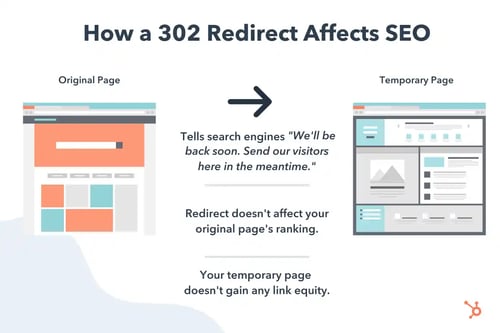If you've spent any time on the internet, chances are you've encountered an HTTP status code.

In simple terms, HTTP status codes are standard response codes that show the relationship between all the things that go on in the background when you travel from web page to web page. Things like the user agent (i.e., your web browser), the server, the web page you're trying to load, and any third-party web applications you might be running.
Because of the complexity of how all those elements interact, there are many possible HTTP status codes you can run up against.
HTTP status codes identify and diagnose the particular blocker preventing you from loading a resource, and can give you information about the journey you took on the way to a page.
In this article, we'll cover what you need to know about the HTTP 302 status code – jargon-free.
What is an HTTP 302?
The 302 status code is a redirection message that occurs when a resource or page you're attempting to load has been temporarily moved to a different location. It's usually caused by the web server and doesn't impact the user experience, as the redirect happens automatically.
For starters, it's helpful to know that all HTTP messages with 3xx are redirection messages.
Say blog.hubspot.com no longer exists, and the content is now permanently housed on blogging.hubspot.com. This would trigger a 301 status code, which indicates a permanent redirection from one location to another.
The 302 redirect, on the other hand, is only temporary. A good example of when to use a 302 status code is for localization and language purposes.
For instance, if you visit a clothing website based in the United Kingdom but you are located in the United States. A 302 redirect would send you to the US version of the site to ensure the currency and other content are displayed correctly, according to your location.
You can also use a 302 status code when:
- Redesigning a page – You can send users to a temporary location while the other page is under construction.
- Conducting A/B tests – Want to test a new page and get feedback on its performance? You can do this with a 302 redirect without hurting your ranking.
- Running a promotion – To drive traffic to a particular offer, you can set up a temporary redirect for a page that usually includes other content.
- A product is sold out – In the case of a sold-out or temporarily unavailable product, you can redirect users to a related page until it is available again.
While this list is not exhaustive, here's the golden rule to keep in mind: Only use a 302 redirect if the change is temporary.
Furthermore, a 302 status code happens on the server-side and shouldn't be noticed by users if set up correctly. The web server serving up the 302 redirect will immediately indicate the new location of the page to your browser (and search engines) and should send users there right away.
How a 302 Status Code Affects SEO
From an SEO perspective, it's important to understand how a 302 status code can impact your ranking and when you should use it.

Firstly, if the location of a page has changed and a redirect has not been set up, this can lead to a 404 status error (i.e., your page cannot be found) and affect your ranking. After all, Google won't want to send users to a page that leads to nowhere.
One benefit of using a redirect like this is that you don't have to sacrifice your ranking when you temporarily send users elsewhere.
Say you're using it to redirect users from a sold-out product page to a relevant product page. You wouldn't want your unavailable product's page to drop in ranking, just because it's currently unavailable. With a 302 status code, you can maintain your ranking.
However, this also means that your temporary URL will not benefit from any link juice because Google knows it won't be there long.
For comparison, a 301 code typically sends most link equity to your new URL, but your page can experience some drop in ranking as a result of the redirect.
How to Identify & Implement an HTTP 302 Error
If you want to see when you've encountered a 302 redirect (or any type of redirect), consider using an application or Chrome extension (like this one, Redirect Path). This type of tool will show you directly in your browser when you run into a redirect. Tools like Pulsetic can be used to monitor websites and send alerts for server or website errors.
You can also view and implement the code from the backend by accessing your .htaccess file. To avoid accessing this file, you can also install a redirect manager plugin or an SEO tool that includes a redirect manager (like Yoast SEO Premium).
Overall, you want to make sure you understand how redirection messages affect SEO. A 302 status code can be a great strategy when making temporary changes to your website, like testing new website features and product promotions.
So, when you're debating between various redirection messages, make sure the one you choose aligns with your long-term strategy.
![→ Download Now: SEO Starter Pack [Free Kit]](https://no-cache.hubspot.com/cta/default/53/1d7211ac-7b1b-4405-b940-54b8acedb26e.png)









